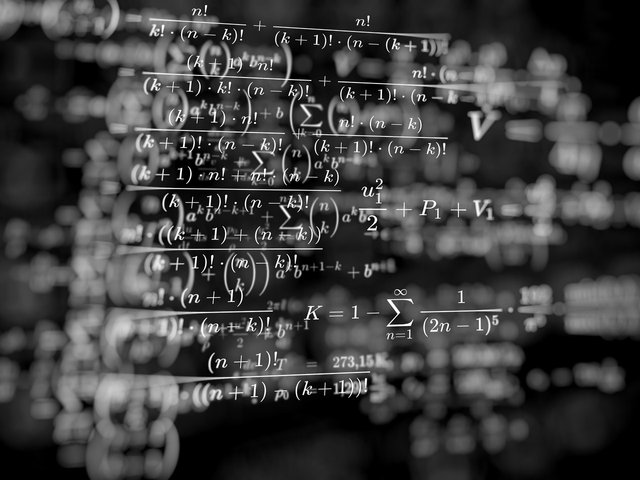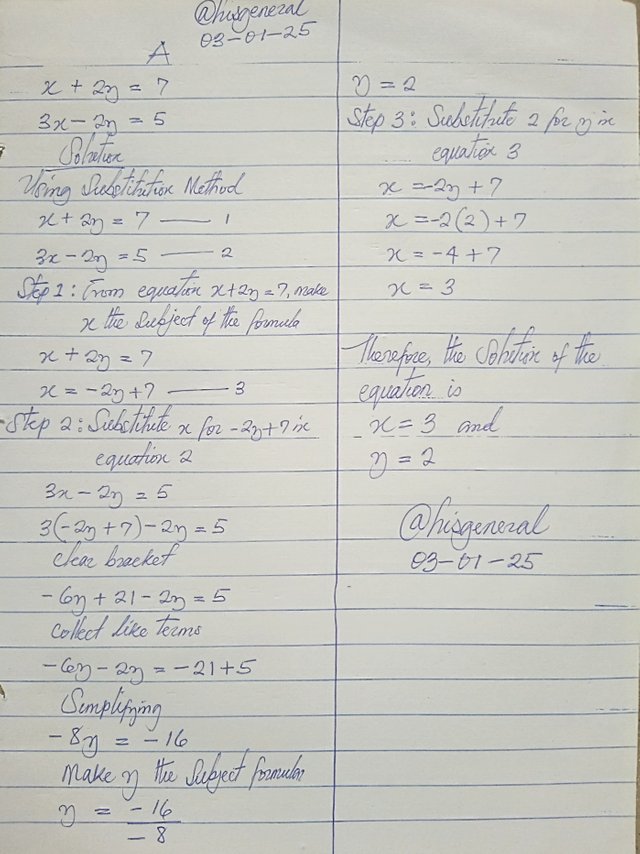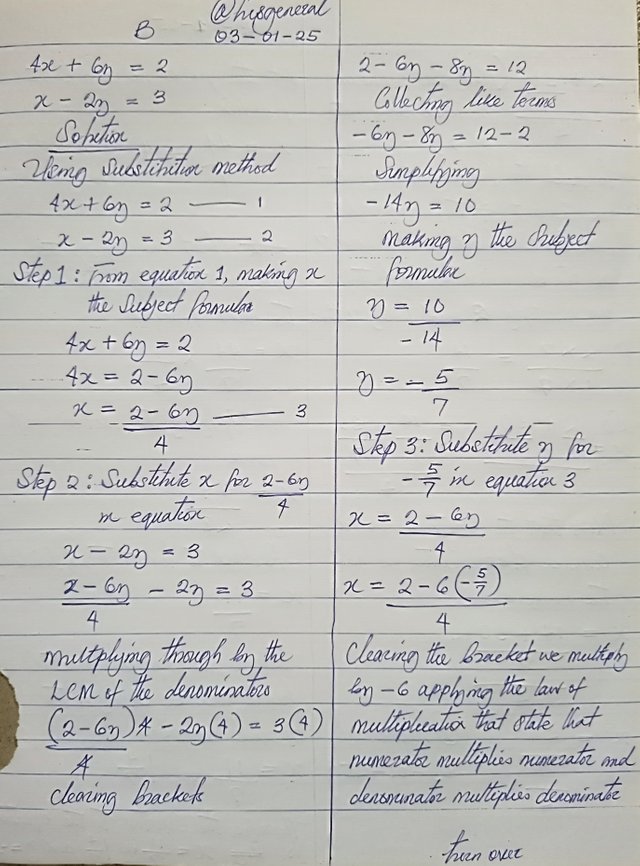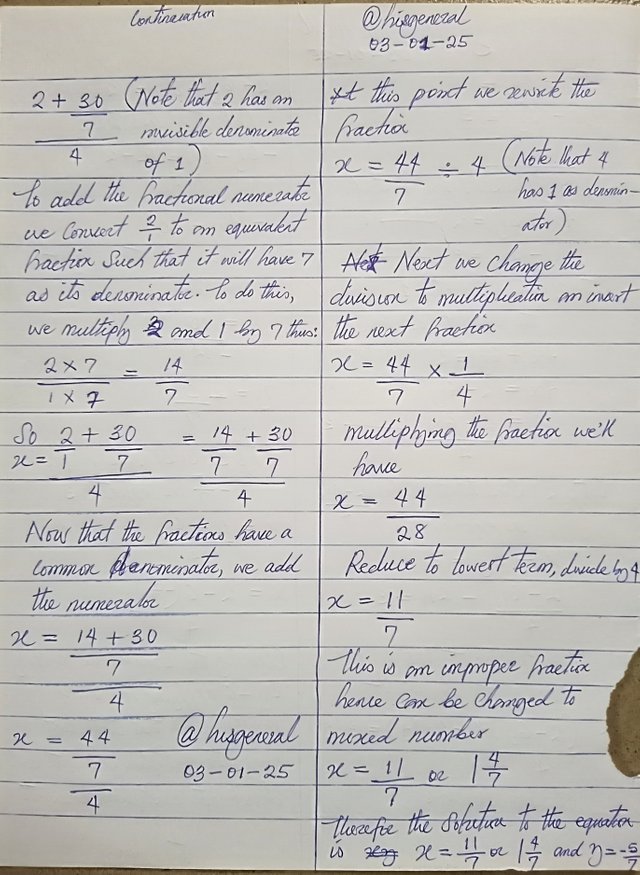SLC-S22W3//Equations and Systems of equations
 Source Source |
|---|
An equation, as we well know, refers to a mathematical statement that expresses the equality of two expressions, usually having variables, arithmetical operations, as well as constants. Equations can be utilized in solving problems, used in representing the association between variables, and modeling real-life situations; these render it a potent tool for analyzing and solving problems.
A system of equations, on the other hand, refers to the collection of equations that have more than one variable, in which the equations are concurrently true. Finding the answer to a system of equations has to do with looking for the values of the variables that make the equation true, usually through the use of methods such as elimination or substitution.
• Task 1
• Explain difference between linear and non linear systems of equations. Provide examples of each type of system of equation and describe their general forms.
The difference between the two can be seen in various aspects such as:
Definition
While linear equation systems have to do with collecting two or more equations in which every equation takes the form of ax - by = c, in which a, b, c are constants and x, y are variables; nonlinear equation systems have to do with collecting two or more nonlinear equations in which every equation isn't in straight line form, e.g polynomial or logarithm equations, e.g log(y) + x = 2.
Graphical Representation
On a coordinate plane, linear systems of equations are graphically represented as straight lines, while on the same coordinate plane, nonlinear systems are represented as shapes or curves
Solutions
While linear systems may be characterized by no solution or unique solutions, nonlinear systems are also known to have manifold solutions.
Solving method
While linear systems are solved by matrix operations, elimination, and substitution methods, nonlinear systems are solved by means of approximation or numerical methods or graphically
| Deals with straight lines | Deals with shapes and curves |
| Has unique solution or no solution | Has multiple solutions |
| Solved by algebraic methods | Calls for numerical or approximation methods |
Examples of Linear Systems of Equations and Nonlinear Systems of Equations
Examples of a linear system of equations
Example 1
4x + 5y = 8
x - 3y = 5
Example 2
x - 6y = 16
2x + 2y = -7
Examples of nonlinear systems of equations
Example 1
x² - y² = 18
x - 2y = 12
Example 2
y = x² - 6
y = 3x + 2
Practical Examples of Linear Systems of Equations and Nonlinear Systems of Equations
Linear Systems of Equations
Daniel and John planned a trip. They intend to drive a total of 360 miles in 5 hours. Supposing they maintained constant velocity, Daniel drives x miles per hour while John is driving 6 miles per hour faster than Daniel. How fast will each of them drive?
If Daniel's speed is x, and John drives 6 miles ahead of Daniel, then John's speed will be x + 6.
Therefore,
x + (x + 6) = 72 => total velocity for 5 hours
x + (x + 6) = 360/5 => total distance for 5 hours
Nonlinear Systems of Equations
Seven Up bottling company produces Mirinda (M) and Pepsi (P). Supposing the gain from the production of x unit of M and y unit of P is given as G(x,y) = 3x² + 4y² - 5xy. There is a limited company budget of ₦2000 for production. The cost of production of x units for M is ₦3x, and the cost of production of y units of P is ₦4y. What will be the best production levels of M and P to maximize gain?
G(x,y) = 3x² + 4y² - 5xy => equation for gain
3x + 4y = 2000 => budget restriction
• Task 2
• Describe any one method for solving system of linear equations and share at least one step by step algebraic example.
(It should be other than substitution, elimination and graphing method)
Besides substitution, elimination, and graphical methods of solving linear systems of equations, other methods, such as matrix, can be used.
This method has to do with expressing linear equations as matrices, getting the determinant or inverse, and then carrying multiplication to solve variables. Systems that have multiple variations and equations are easily solved by this method, it serves as an influential device for linear algebra.
Let's consider this example:
5x - 6y = 17
x - y = 10
We will be solving the above equation using an augmented matrix.
Step 1: Express the equation as an augmented matrix
5x - 6y = 17 — (1)
x - y = 10 — (2)
this will be written as
[ 5 -6 ] [ 17 ]
[ 1 -1 ] [ 10 ]
Step 2: Getting the determinants of the coefficients matrix
The determinant of a 2-by-2 matrix is given as
det(A) = ad - bc; where A stand for the matrix
[a b]
[c d]
In this case, our coefficient matrix is
[5 -6]
[1 -1]
Therefore, our determinant will be
det(A) = (5)(-1) - (-6)(1)
Clearing brackets
(5 × (-1)) - (6 × 1)
= -5 + 6
= 1
Step 3: Getting the inverse of the coefficient matrix
Our determinant here is 1 (non-zero); therefore, the coefficient matrix has an inverse.
The inverse of a 2-by-2 matrix is given as
A-1 = [1/det(A)] × [ d -b ]
[ -c a ]
Here, the inverse of the coefficient matrix will be
A-1 = [1/1] × [ -1 -6 ]
[ -1 5 ]
Step 4: Using the constant matrix to multiply the inverse of the coefficient
At this point, we will get the solution by multiplying the inverse of the using the constant matrix
x = A-1 × b; where b is a constant
[ 17 ]
[ 10 ]
Therefore, we will have that
x = [ -1 6 ] × [ 17 ]
[ -1 5 ] × [ 10 ]
hence
x = [ (-1)(17) + (6)(10) ]
[ (-1)(17) + (5)(10) ]
multiplying out, we will have
x = [ -17 + 60 ]
[ -17 + 50 ]
x = [ 43 ]
[ 33 ]
Therefore,
x = 43
y = 33
• Task 3
• You need for solving following system of linear equations:
(a)
x + 2y = 7
3x - 2y = 5
(b)
4x + 6y = 2
x - 2y = 3
(You are required to solve these problems at paper and then share clear photographs for adding a touch of your creativity and personal effort which should be marked with your username)
x + 2y = 7
3x - 2y = 5

4x + 6y = 2
x - 2y = 3

continuation on B

• Task 4
Scenario number 1
Suppose there's a company producing two products, A and B. If cost of producing x units of A and y units of B is given by system then;
2x + 3y = 130 (cost of materials)
x + 2y = 110 (cost of labor)
If company wants for producing 50 units of product A then calculate how much units of product B they may produce?
(Solve the above scenario based questions and share step by step that how you reach to your final outcome)
To calculate how many units of product B the company will produce, the system of the equation should be solved for y when x = 50.
Step 1: Write out the given equations
2x + 3y = 130 — 1
x + 2y = 110 — 2
Step 2: Substitute 50 for x in equation 2
x + 2y = 110
50 + 2y = 110
Step 3: Solve for y
Make 2y the subject formula
2y = 110 - 50
Carry out the subtraction on the right-hand side of the equation
2y = 60
Make y the subject formula
y = 60/2
y = 30
Consequently, if the company wants to produce 50 units of product A then they will produce 30 units of product B.
Scenario number 2
• Suppose there's a bakery producing two types of cakes which are vanilla and chocolate.If cost of producing x cakes of vanilla and y cakes of chocolate is given by system then;
x + 2y = 80 (cost of ingredients)
2x + y = 70 (cost of labor)
If bakery wants for producing 30 cakes of vanilla then calculate how much cakes of chocolate can they produce?
The system of equations we will need to solve to calculate the number of cakes that the bakery will produce will be for y when x = 30
Step 1: Write out the given equations
x + 2y = 80 — 1
2x + y = 70 — 2
Step 2: Substitute 30 for x in equation 1
x + 2y = 80
30 + 2y = 80
Step 3: Solve for y
Make 2y the subject formula
2y = 80 - 30
Subtracting 30 from 80
2y = 50
Make y the subject formula
y = 50/2
y = 25
Therefore, if the bakery wants to produce 30 cakes of vanilla they will also produce 25 cakes of chocolate.
Thanks
Inviting @eveetim, @ngoenyi and @nsijoro
Cc:
@khursheedanwar
X promotion link